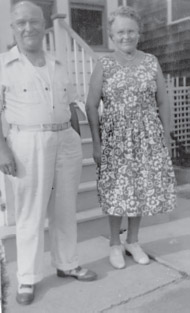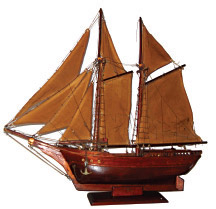| |
Sea Chanty
 |
| Jerry and Alice Tulk, the author’s grandparents |
The old man lived alone now in the white cottage that he had built by the sea when he was young and strong and happy.
His wife had died two years before, and he had painted the cottage then, taking meticulous care, telling one of his daughters that it would be the last time.
He slept little and fitfully, waking just before dawn. He drank strong black tea and then set out on his daily walk along the beach to where the boats from the fisheries came in. The bright silvery rainbow catch shimmered and flopped in the morning sun. Sometimes a shark would be among them, unmoving, its quiet eyes open and staring into the approaching abyss. He wanted to stroke its skin, and comfort it. But he passed on.
When he slept, his dreams were of the twomasted Newfoundland fishing schooner, the Effie M. Morrissey, that he had sailed on in his youth. He heard the creak and the boom of wind-shot sails, and smelled the tar and brine and the acrid sweat of his shipmates. He looked to the blue and distant horizon from his rocking perch in the rigging, and felt the swell and power of the vessel beneath him
That spring, he went to the town lumber yard and bought a single block of dark mahogany on special order. On his small porch, patiently, slowly, with great exactness, from the blueprint of memory, using his finely honed jack knife, he shaped the block into the hull of the sleek ship that coursed through his dreams. From time to time, he held the emerging hull at arm’s length and measured it against his mental image. At those times, he permitted himself a small smile of satisfaction and accomplishment.
When the hull was perfectly shaped, he hollowed it out, and sanded it until it was as smooth as the sea-buffed driftwood on the beach. Then he applied coat after coat of shellac until the wood achieved the proper deep sheen.
 |
Replica Newfoundland fishing schooner the Alice B. Wellon, christened with his grandmother’s maiden name.
Photo of ship, author’s niece, Lia Conti |
Setting aside the completed hull, he went again to the lumber yard for a sheet of thin plywood, from which he fashioned the decks of his ship — the forecastle and the poop deck, the main deck, the berth, and the orlop over the bilge. He stained the decks the same color as the hull. He knew each deck in memory as clearly if he had just stepped ashore from his last voyage, and he had traced and measured and cut so that they fit the hull as truly as the shrinking figures in a Russian doll.
Before he had fitted the decks into the hull, he had attached a rudder to the ship’s stern, and run a thin wire from it to the miniature ship’s wheel on the main deck, so that when it was turned the rudder actually moved. He had painstakingly carved the wheel over several weeks. Over the wheel, he placed a tiny working compass that he had found in a junk shop years ago and kept. He also carved a ladder that went from the main deck below decks. The red and green starboard and larboard running lights were made from painted dice. The portholes were the eyelets that he had kept from an old corset. Now he understood why. From a common kitchen spoon, he fashioned and anchor which hung by a tiny chain from the prow.
Then he went to a music store in the town and bought two drumsticks and cut one slightly taller and stained them and they became his ship’s foremast and aft mast.
It next remained to gaff rig his schooner of memory .He used wooden knitting needles, sanded and shaped, to form the yardarms and spars, which he joined to the masts through small holes he bored with a tiny, delicate awl, and he found light canvas in the local marine supplies store from which he cut his sails — the jib, the fore staysail, the gaff topsail, the foresail, the main gaff topsail, and the mainsail.. For the stays themselves, which are the ropes that attach the sails to the yardarms and spars, he used waxed household string which he untwined and re-wrapped to the thickness he wanted. The smallest of ordinary grommets attached the spars to the sails, which then could actually be raised and lowered and furled and unfurled. The rigging he made with the same waxed string.
He had gone to the Boardwalk one night and strolled slowly through the summer throngs, smiling at the memories they evoked, and bought two cheap identification bracelets at a honky-tonk variety store. Back at the cottage, he removed the chains from the bracelets.
When he had sailed before the mast, he and his mates had passed the long hours between watches by teaching themselves calligraphy. They honed their penmanship until their signatures were as florid and formal as any lord’s or earl’s. Now the old man took a pen and sheet of white paper and practiced until the skill flowed back into his hand and he was satisfied with it. He had a small electric drill, and he selected the smallest, finest bit he had and slowly inscribed “Alice B. Wellon” on each of the bracelets and fastened them with tiny screws to either side of the ship’s prow as nameplates. Alice B. Wellon had been his wife’s maiden name.
There remained the final, crowning addition. Again he had traipsed the Boardwalk. He knew he would find what he needed among the endless souvenirs and bric-a-brac in the beach stores. At the third store, he saw them - wide bracelets with the flags of various nations fixed to them. The flags were of cloth. Perfect. He bought two with the Union Jack on them and brought them home and steamed the flags off the bracelets, glued them back to front, and attached them to the top of the foremast. The Alice B. Wellon, a Newfoundland fishing schooner, now stood proud and tall, spanking and seaworthy. His labor had taken eight months.
That old man was my grandfather. Now I, in my turn, am an old man, and I have already lived longer than he did. And in all my years, and of the thousands of people I have known, he was the most self-possessed. His gaze was untroubled, totally aware, steady as the north star, and he spoke in a voice of quiet authority tinged with humor. He took life seriously, but not himself.
His family came from County Cork in Ireland to the port of Liverpool in England and then on to Newfoundland where they settled in a bleak village called Ladle Cove.
My grandfather and his father built a saw mill on a cliff there and woke one morning to find that the cliff and their livelihood had fallen into the sea in the night.
So my grandfather moved himself to Trenton, New Jersey, leaving a wife pregnant with their first child in Ladle Cove. Finding no place in Trenton for his talents, he came to Camden, New Jersey, and found work as the first power plant engineer at the fledgling Campbell Soup Company. He studied for all of a week to pass the test for his coveted green card. He ran the boiler room on ingenuity, spit, wire, and common sense.
He sent for my grandmother and my mother, who was six weeks old when she left Newfoundland. He rented a house in Camden near the Campbell plant and then moved his growing family to the suburbs of Westmont where he bought a twin house next to a coal yard with a high white tower and installed his sister Naomi and her family in the other half of the twin.
My grandfather always referred to John Dorrance, the founder of Campbell’s, as “old man Dorrance.” The soup patriarch would often come to the power plant and he and my grandfather would drink strong tea and talk for hours. Dorrance claimed that my grandfather’s conversation influenced many of his crucial business decisions.
The middle finger of my grandfather’s left hand was a stub that ended at the first joint. When as a child I asked about it he said that he had been at work one day and made a mistake with a piece of machinery and the finger was cut halfway off. He took a hatchet and finished the job, plunged the bloody stump into a raw potato to stanch the blood, and went back to work.
The year that he crafted the Alice B. Wellon, he presented it to my mother, his oldest child, at Christmas. She always said it was the best gift she ever received. It stood on the mantel through my childhood, and now in turn graces my mantel.
The next spring, my grandfather sold the white seaside cottage and came to live with us. One radiant morning, he took a long walk through the woods along the creek in our town. When he came back, he informed my mother, “I’ll be joining mom soon.”
The next week, he took to his bed. The doctor was called. He found nothing seriously wrong. That night, my grandfather composed himself and passed.
Sail on, sailor.
|
|
